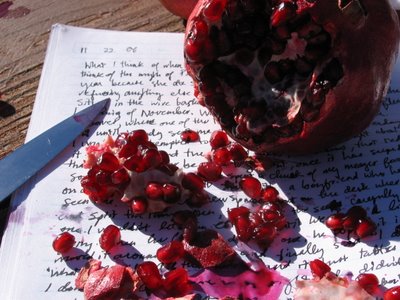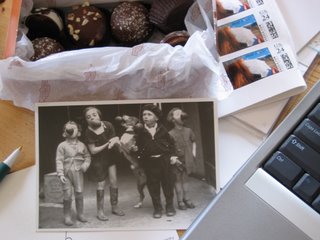 A little poetry-inspired photography
A little poetry-inspired photography Out here in the middle of the San Juan mountain range in Colorado, on a ranch with three wolfhounds, four cats and two horses, when the other two writers who come and go here are out of town, there are no poetry readings, unless you count the wind whistling through the gaps in the wall of the barn, or the readings I do for myself.
So, I figure I better count the readings I do for myself, which is why I was so excited to get the poem below. Wendy Trevino, a grad student at UC Davis who
roomed with me and Dana at the Tomales Bay Workshops, sent it to me yesterday, and I'd like to present it to you as my virtual reading:
portrait of a cracked pomegranate
light's rubbed clean
through garnet pulp
to the starlight of
seeds behind which
other seeds glow
dimly - all this
a membrane holds
in such tremble
a visible extension
of pith taut with
the pressure of all
these seeds inside
this radiant carapace
- Wendy Trevino
What I think of when I think of pomegranates is seduction. I think of the myth of Persephone, daughter of the goddess of the harvest, who was kidnapped and taken to the underworld by Hades, and of how winter came about because she ate pomegranate seends, unable to resist them after refusing everything else from Hades.
Since the beginning of November, we've had three pomegranates sitting in the wire basket that hangs from the kitchen ceiling. When I said goodbye to Wendy and left the workshop, I flew to Denver, where one of the things I bought was one of those pomegranates. But until Wendy sent me her poem yesterday, I hadn't been tempted to open it. Here's what I thought about it - too messy, and the kind of mess that stains, that red juice that you will never be able to get out once it has seeped into something.
In college, I once spent a chunk of my meager food budget on a pomegranate to share with a boyfriend who had never seen one before. We spread newspapers on the desk where I studied, and split the thing open, carefully picking out the seeds one by one. I wouldn't let him taste any until there was a nice sized pile in front of us. Finally, he popped one into his mouth, moved it around a little, and then looked at me and said "I don't get it." I must have given him a look, and then he said "All that work for that little thing? I don't get it."
And, outside of our nice Poetry Thursday circle, isn't that what we hear people say about poetry? Maybe not out loud, but in other ways. Sometimes, working on a poem, struggling with the tough rind of rhythm, line endings, stanzas, I feel the same way myself. Sometimes it's a lot of work for what turns out to be a pretty unsuccesful fruit.
Which is why I love Wendy's poem so much. It seduced me, made me want to brave the mess and open the pomegranates in that basket, even though I knew I would not be eating fruit that old. She made a tough thing look juicy, and wrote a poem that, to me, is a meditation on the hard work of poetry itself.
Besides - "radiant carapace"? I love that!
Go ahead, read it again. You know you want to.





